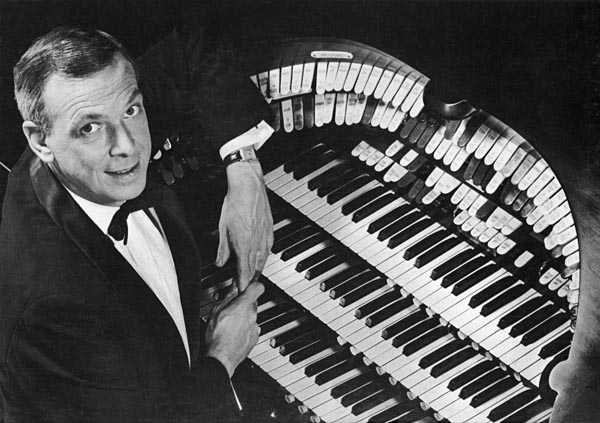
|
|

George Wright, legendary master of the Theatre Pipe Organ. |
|
The Theatre Pipe Organ runs on electricity to supply the "keyers", "stops" and "air blowers". The air, from a large duct at the output of the blower, is held in wooden boxes called "regulators". These have coil spring loaded lids on leather bellows and are connected through smaller ducts to more wooden boxes called "chests" that have the pipes fitted into holes in their tops. The regulators keep the air under even pressure, no matter how many pipes play at once. Each pipe has a valve that opens when a note is played by a key that has that set of pipes turned on by a "Stop Tongue", one of the many multicolored stop control switches surrounding the keyboards of the console. A key can play a note from as many or few pipes that are turned on at the same time for that key. The keys and stops, along with all the valves for the pipes, are connected together by a device known as a "Relay", analogous to a telephone switchboard matrix. This relay puts the signals from the controls and keys in the right places at the right time. In the early days, it was operated by air and electromagnets. Today, computers are used to control the keys and stops, but the electromagnets on the stop and pipe valves remain. The stop tongues, once air driven, are now electromagnetic. The musician presses a stop tongue down. This sends a signal to the relay, which opens the stop valve for that set of pipes. He or she then presses a key, causing the relay to send a signal to open a pipe valve, allowing air to blow into the pipe for that key. The air causes a vibration in the pipe, and a note comes out into the room. The principle of operation is simular to the way a whistle works, hence the nickname "box of whistles." A Theatre Pipe Organ can have thousands of pipes of all different kinds. The pipes are arranged in "ranks", wherein the pipes of a rank, small to large, are all alike. Each rank has one or more stops that turn it on or off. We see organs referred to as 3/16, 4/32, etc. The first number signifies how many "Manuals" or keyboards are in the console. The second number signifies how many different ranks of pipes are in the organ. The sounds of these pipes mimick orchestral instruments, like the Trumpet, Flute and the Violin. Other pipes are unique in sound and have no orchestral counterpart. These are the Diapasons. Diapasons are the backbone of any organ and they give it majesty and power like no other musical instrument known to man. You can hear these playing in churches and theatres around the world. To get a very detailed look at the inner workings of a Theatre Pipe Organ, visit the theatreorgans.com website at the Anatomy of a WurliTzer Theatre Pipe Organ page. |